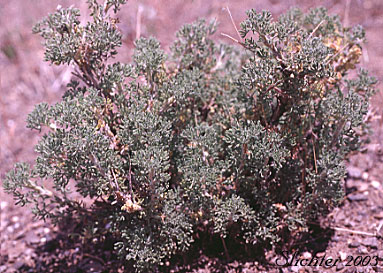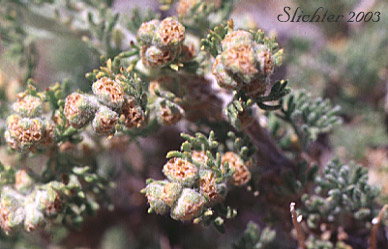

 The photo at right shows a close-up of the flower heads and leaves of bud sage at the intersection
of the Fields-Denio Highway, Domingo Pass Road, eastern base of the Pueblo Mts,
southeastern Oregon.........May 27, 2000.
The photo at right shows a close-up of the flower heads and leaves of bud sage at the intersection
of the Fields-Denio Highway, Domingo Pass Road, eastern base of the Pueblo Mts,
southeastern Oregon.........May 27, 2000.
Bud sage is a dwarf, bushy, rounded shrub from 5-50 cm high. The older stems are stout with shredded bark. Many of the older flower branches are hard and pointed, forming spine-like projections. The leaves and young stems are covered with fine hairs. The slender-petioled leaves are about 2 cm long and divided into 3-5 thin segments, each segment often divided again into narrow, sometimes spatulate segments. The leaves form in early spring and are deciduous by midsummer.
The inflorescence is short and spike-like to raceme-like and consists of dense clusters of flower heads. The involucre is 2-3.5 mm high, its 4-8 bracts densely covered by long, soft, shaggy hairs and leaf-like. The 5-12 disk flowers are sterile and surrounded by 2-6 outer, fertile flowers. Bud Sage flowers from April through June.
Bud sage is found on dry plains an hills between the elevations of 700-2100 meters. It is somewhat tolerant of alkali.
Bud sage is found from southeastern Oregon south to California, Arizona and New Mexico and east through central Idaho to western Montana.